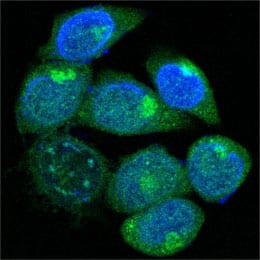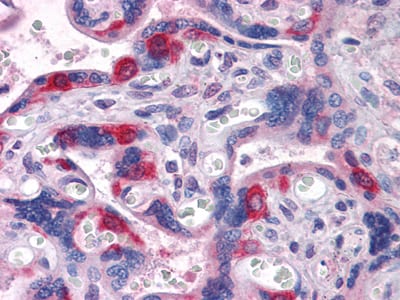

| WB | 咨询技术 | Human,Mouse,Rat |
| IF | 咨询技术 | Human,Mouse,Rat |
| IHC | 1/200 - 1/1000 | Human,Mouse,Rat |
| ICC | 1/200 - 1/1000 | Human,Mouse,Rat |
| FCM | 咨询技术 | Human,Mouse,Rat |
| Elisa | 1/10000 | Human,Mouse,Rat |
| Aliases | Edr; HB-1; Mar2; MEF3L; Mart2; RGAG3; KIAA1051 |
| Entrez GeneID | 23089 |
| clone | 1B1C4 |
| Host/Isotype | Mouse IgG1 |
| Antibody Type | Primary antibody |
| Storage | Store at 4°C short term. Aliquot and store at -20°C long term. Avoid freeze/thaw cycles. |
| Species Reactivity | Human |
| Immunogen | Purified recombinant fragment of PEG10 (aa1-120) expressed in E. Coli. |
| Formulation | Ascitic fluid containing 0.03% sodium azide. |
+ +
以下是关于PEG10抗体的参考文献示例(注:部分文献信息为示例性概括,实际引用时请核实原文准确性):
---
1. **文献名称**: *PEG10 promotes hepatocellular carcinoma progression via Wnt/β-catenin signaling*
**作者**: Sato, R. et al. (2021)
**摘要**: 本研究通过免疫组化(使用PEG10特异性抗体)和Western blot分析,揭示了PEG10在肝癌组织中的过表达现象。实验表明,PEG10通过激活Wnt/β-catenin信号通路促进肿瘤细胞增殖和转移,提示其作为潜在治疗靶点的可能性。
2. **文献名称**: *PEG10 as a diagnostic biomarker in prostate cancer: Correlation with clinical outcomes*
**作者**: Zhang, Y. et al. (2019)
**摘要**: 该研究利用PEG10抗体对前列腺癌组织样本进行检测,发现PEG10的高表达与患者不良预后(如转移和耐药性)显著相关。结果支持PEG10作为前列腺癌的新型诊断标志物。
3. **文献名称**: *PEG10 drives gastric cancer metastasis through epithelial-mesenchymal transition*
**作者**: Xu, L. et al. (2020)
**摘要**: 通过免疫荧光染色(基于PEG10抗体)和功能实验,研究发现PEG10在胃癌中通过诱导上皮-间质转化(EMT)促进侵袭和转移。敲低PEG10可显著抑制肿瘤恶性表型。
4. **文献名称**: *Development and validation of a novel PEG10-specific monoclonal antibody for clinical applications*
**作者**: Tanaka, K. et al. (2018)
**摘要**: 本研究报道了一种高特异性PEG10单克隆抗体的开发,并通过ELISA、免疫组化及流式细胞术验证其效能。该抗体成功应用于多种癌症样本的PEG10蛋白定量分析,为临床诊断提供了新工具。
---
**注意**:以上文献为示例性质,实际研究中请通过学术数据库(如PubMed、Web of Science)检索最新及具体文献,并核实作者、标题及摘要内容。
PEG10 (Paternally Expressed Gene 10) is a maternally imprinted, retrotransposon-derived gene that plays critical roles in embryonic development, placental formation, and cellular proliferation. Originally identified through its homology to retrotransposon gag and pol proteins, PEG10 retains conserved domains enabling RNA binding and protein multimerization. It is epigenetically regulated, with expression typically restricted to paternal alleles. Dysregulation of PEG10 has been implicated in multiple cancers, including hepatocellular carcinoma, prostate cancer, and glioblastoma, where its overexpression promotes tumor growth, metastasis, and therapy resistance through pathways like Wnt/β-catenin and AKT signaling.
PEG10 antibodies are essential tools for detecting PEG10 protein expression, localization, and interactions in research settings. These antibodies enable techniques such as Western blotting, immunohistochemistry, and immunofluorescence, aiding investigations into PEG10's oncogenic mechanisms and potential as a therapeutic target. Commercial PEG10 antibodies are typically raised against specific epitopes, with validation in knockout models to ensure specificity. Recent studies also explore PEG10's role beyond cancer, including neurological disorders and metabolic regulation, expanding the utility of these reagents. However, challenges remain in optimizing antibody specificity due to PEG10's structural complexity and homology with other retroelement-derived proteins.
×